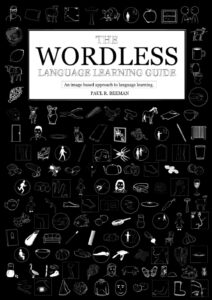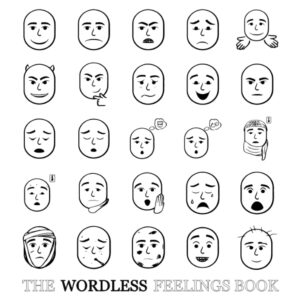Wordless Books

Instead of written words, wordless books rely solely on visual cues – to convey meaning, emotions, and stories. These visual prompts encourage active participation from the learner, fostering imagination and critical thinking skills.
How Wordless Books Support Language Acquisition:
Wordless books offer a unique and engaging approach to language learning, providing opportunities to:
- Develop vocabulary: Learners can describe what they see in the illustrations, building their vocabulary related to objects, actions, emotions, and settings.
- Practice grammar: Creating a narrative based on the images allows learners to practice sentence structure, verb tenses, and descriptive language. They can tell the story in the past, present, or future tense, focusing on accurate grammatical constructions.
- Enhance comprehension: Interpreting the illustrations requires careful observation and analysis, improving learners’ comprehension skills and their ability to infer meaning from context.
- Boost confidence: Without the pressure of reading text, learners can focus on the spoken language.
- Engage diverse learners: Wordless books are particularly beneficial for visual learners and those who are new to a language, as they provide a low-pressure entry point to storytelling and language practice. They transcend language barriers, making them an inclusive resource for multilingual classrooms.
Wordless Books By Lancer Learning Communities:
- The Wordless Language Learning Guide
 The Wordless Language Learning Guide Written and Illustrated by Paul R. Beeman Learn language naturally! With over 1000 hand-drawn images, this user-friendly guide introduces learners to vocabulary naturally, without the hassle of translation. The Wordless Language Learning Guide… Read more: The Wordless Language Learning Guide
The Wordless Language Learning Guide Written and Illustrated by Paul R. Beeman Learn language naturally! With over 1000 hand-drawn images, this user-friendly guide introduces learners to vocabulary naturally, without the hassle of translation. The Wordless Language Learning Guide… Read more: The Wordless Language Learning Guide - The Wordless Action Book
 The Wordless Action Book Simple images for easy learning. 49 realistic, black and white illustrations to build your learner’s action vocabulary. Whether your learner is a child developing language skills or an adult learning their 4th language, these… Read more: The Wordless Action Book
The Wordless Action Book Simple images for easy learning. 49 realistic, black and white illustrations to build your learner’s action vocabulary. Whether your learner is a child developing language skills or an adult learning their 4th language, these… Read more: The Wordless Action Book - The Wordless Produce Book
 The Wordless Produce Book 36 realistic, black and white illustrations to build your learner’s produce vocabulary. Whether your learner is a child developing language skills or an adult learning their 4th language, these images are designed to help… Read more: The Wordless Produce Book
The Wordless Produce Book 36 realistic, black and white illustrations to build your learner’s produce vocabulary. Whether your learner is a child developing language skills or an adult learning their 4th language, these images are designed to help… Read more: The Wordless Produce Book - The Wordless Feelings Book
 The Wordless Feelings Book Simple images for easy learning. 25 black and white illustrations to help your learner describe feelings. Whether your learner is a child developing language skills or an adult learning their 4th language, these images… Read more: The Wordless Feelings Book
The Wordless Feelings Book Simple images for easy learning. 25 black and white illustrations to help your learner describe feelings. Whether your learner is a child developing language skills or an adult learning their 4th language, these images… Read more: The Wordless Feelings Book - The Wordless Vehicle Book
 The Wordless Vehicle Book 36 realistic, black and white illustrations to build your learner’s vehicle vocabulary. Whether your learner is a child developing language skills or an adult learning their 4th language, these images are designed to help… Read more: The Wordless Vehicle Book
The Wordless Vehicle Book 36 realistic, black and white illustrations to build your learner’s vehicle vocabulary. Whether your learner is a child developing language skills or an adult learning their 4th language, these images are designed to help… Read more: The Wordless Vehicle Book - The Wordless Animal Book
 The Wordless Animal Book Simple images for easy learning. 36 realistic, black and white illustrations to build your learner’s animal vocabulary. Whether your learner is a child developing language skills or an adult learning their 4th language, these… Read more: The Wordless Animal Book
The Wordless Animal Book Simple images for easy learning. 36 realistic, black and white illustrations to build your learner’s animal vocabulary. Whether your learner is a child developing language skills or an adult learning their 4th language, these… Read more: The Wordless Animal Book - The Wordless Clothing Book
 The Wordless Clothing Book Simple images for easy learning. 36 realistic, black and white illustrations to build your learner’s clothing vocabulary. Whether your learner is a child developing language skills or an adult learning their 4th language, these… Read more: The Wordless Clothing Book
The Wordless Clothing Book Simple images for easy learning. 36 realistic, black and white illustrations to build your learner’s clothing vocabulary. Whether your learner is a child developing language skills or an adult learning their 4th language, these… Read more: The Wordless Clothing Book